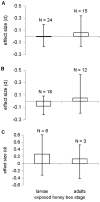A meta-analysis of effects of Bt crops on honey bees (Hymenoptera: Apidae)
- PMID: 18183296
- PMCID: PMC2169303
- DOI: 10.1371/journal.pone.0001415
A meta-analysis of effects of Bt crops on honey bees (Hymenoptera: Apidae)
Abstract
Background: Honey bees (Apis mellifera L.) are the most important pollinators of many agricultural crops worldwide and are a key test species used in the tiered safety assessment of genetically engineered insect-resistant crops. There is concern that widespread planting of these transgenic crops could harm honey bee populations.
Methodology/principal findings: We conducted a meta-analysis of 25 studies that independently assessed potential effects of Bt Cry proteins on honey bee survival (or mortality). Our results show that Bt Cry proteins used in genetically modified crops commercialized for control of lepidopteran and coleopteran pests do not negatively affect the survival of either honey bee larvae or adults in laboratory settings.
Conclusions/significance: Although the additional stresses that honey bees face in the field could, in principle, modify their susceptibility to Cry proteins or lead to indirect effects, our findings support safety assessments that have not detected any direct negative effects of Bt crops for this vital insect pollinator.
Conflict of interest statement
Figures


Similar articles
-
Does Cry1Ab protein affect learning performances of the honey bee Apis mellifera L. (Hymenoptera, Apidae)?Ecotoxicol Environ Saf. 2008 Jun;70(2):327-33. doi: 10.1016/j.ecoenv.2007.12.002. Epub 2008 Feb 21. Ecotoxicol Environ Saf. 2008. PMID: 18206234
-
Bt Toxin Cry1Ie Causes No Negative Effects on Survival, Pollen Consumption, or Olfactory Learning in Worker Honey Bees (Hymenoptera: Apidae).J Econ Entomol. 2016 Apr 27;109(3):1028-1033. doi: 10.1093/jee/tow088. J Econ Entomol. 2016. PMID: 27122497
-
Bt Cry1Ie Toxin Does Not Impact the Survival and Pollen Consumption of Chinese Honey Bees, Apis cerana cerana (Hymenoptera, Apidae).J Econ Entomol. 2016 Dec 1;109(6):2259-2263. doi: 10.1093/jee/tow204. J Econ Entomol. 2016. PMID: 27670271
-
Bacillus thuringiensis (Bt) transgenic crop: an environment friendly insect-pest management strategy.J Environ Biol. 2008 Sep;29(5):641-53. J Environ Biol. 2008. PMID: 19295059 Review.
-
Climate change: impact on honey bee populations and diseases.Rev Sci Tech. 2008 Aug;27(2):485-97, 499-510. Rev Sci Tech. 2008. PMID: 18819674 Review. English, French.
Cited by
-
Impact of Transgenic Cry1Ab/2Aj Maize on Abundance of Non-Target Arthropods in the Field.Plants (Basel). 2022 Sep 26;11(19):2520. doi: 10.3390/plants11192520. Plants (Basel). 2022. PMID: 36235387 Free PMC article.
-
Identification of relevant non-target organisms exposed to weevil-resistant Bt sweetpotato in Uganda.3 Biotech. 2014 Jun;4(3):217-226. doi: 10.1007/s13205-013-0153-1. Epub 2013 Jul 23. 3 Biotech. 2014. PMID: 28324435 Free PMC article.
-
Potential effects of oilseed rape expressing oryzacystatin-1 (OC-1) and of purified insecticidal proteins on larvae of the solitary bee Osmia bicornis.PLoS One. 2008 Jul 16;3(7):e2664. doi: 10.1371/journal.pone.0002664. PLoS One. 2008. PMID: 18628826 Free PMC article.
-
A 2-year field study shows little evidence that the long-term planting of transgenic insect-resistant cotton affects the community structure of soil nematodes.PLoS One. 2013 Apr 16;8(4):e61670. doi: 10.1371/journal.pone.0061670. Print 2013. PLoS One. 2013. PMID: 23613899 Free PMC article.
-
RNAi-mediated mortality of the whitefly through transgenic expression of double-stranded RNA homologous to acetylcholinesterase and ecdysone receptor in tobacco plants.Sci Rep. 2016 Dec 8;6:38469. doi: 10.1038/srep38469. Sci Rep. 2016. PMID: 27929123 Free PMC article.
References
-
- Mendelhsohn M, Kough J, Vaituzis Z, Mathews K. Are Bt crops safe? Nat Biotechnol. 2003;21:1003–1009. - PubMed
-
- OECD. 2007. Consensus document on safety information on transgenic plants expressing Bacillus thuringiensis - derived insect control proteins. OECD Environment, Health and Safety Publications Series on Harmonization of Regulatory Oversight in Biotechnology, 2007 No. 42. Paris Environment Directorate, Organisation for Economic Co-operation and Development.
-
- de Maagd RA, Bravo A, Berry C, Crickmore N, Schnepf HE. Structure, diversity, and evolution of protein toxins from spore-forming entomopathogenic bacteria. Annu Rev Genet. 2003;37:409–433. - PubMed
-
- O'Callaghan M, Glare TR, Burgess EPJ, Malone LA. Effects of plants genetically modified for insect resistance on nontarget organisms. Annu Rev Entomol. 2005;50:271. - PubMed
Publication types
MeSH terms
Substances
LinkOut - more resources
Full Text Sources

